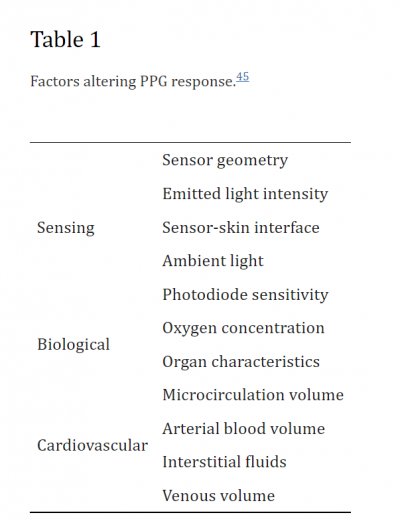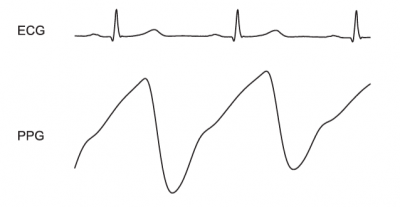Table of Contents
Photoplethysmography (PPG)
Overview
The Photoplethysmography (PPG) also known as Blood Volume Pulse (BVP) is a non-invasive, low-cost biosignal sensor predominantly used in medical and psychophysiological settings to measure the heart rate. In the former case, it is used as a transportable (mobile or wearable) alternative to Electrocardiograms (ECG) outside of clinical settings, whereas in the latter it is often used in biofeedback, a technique to gain awareness and control over physiological functions that affect mental or neurobiological conditions. Furthermore, the Heart Rate Variable (HRV) derived from PPG signal can be effectively used as an indicator for emotion recognition most effectively alongside other biosignals such as EDA, EMG, or respiration sensing. Alongside other biosignal sensing devices, PPG has also been used in artistic audiovisual installations, typically collecting sensor data from an audience to create an evolving installation environment. 1
Background
The term photoplethysmography was first introduced by Alrick Herzman and colleagues from the Department of Physiology at St. Louis University School of Medicine in the 1930s as “photoelectric plethysmography” based on the principle of light absorption by transilluminated tissue which varies based on the blood content. In 1938, Hertzman performed a validation of his PPG method comparing blood volume changes with measurements taken simultaneously by mechanical plethysmography. He then contended that a good skin contact for this method is required but without a pressure that can cause blanching of the site of measurement. He further concluded that sensor displacement can affect the measurement accuracy. But it was not until the development of pulse oximeter in the 1970s to measure patients’ blood oxygen saturation that a major advancement in clinical use of PPG was introduced which led to developments in computer-based digital signal processing and analysis.
Measurement Principles & Types
The principle of operation of PPG is based on a non-invasive optical contact sensor that emits an infrared or green LED to measure the heart rate based on the volume of blood that passes through the tissues in a specific body site with the pads of the fingers or the earlobes being the most common. The light emitted to the tissue is then reflected back to the photodetector of the sensor which indicates the blood volume as the hemoglobin in the blood selectively absorbs the light reflected by other tissues. In this manner, the sensor directly measures the changes in blood volume in the arteries and capillaries of the tissues that it is in contact with which corresponds to changes in the heart rate and blood flow. While infrared is used to measure deep blood concentration in body parts such as muscles, green light often measures the oxygen absorption in oxygenated and unoxygenated blood. Green LED is considered to offer more accurate measurement in some literature as it is less prone to motion artifacts when compared to infrared. The PPG Waveform is constituted by plotting the variation in intensity of the reflected light over time.
There are two types of sensor arrangements for PPG signals: transmission mode and reflectance mode. In transmission mode the light and the detector are put on either side of the tissue while in reflectance mode they are positioned on the same side of the tissue. It is noteworthy that in transmission mode too much pressure on the tissue can affect the blood flow which in turn will affect the measurement. Common sites for transmission mode are fingers and earlobe whereas forehead, wrist, forearm, torso, and ankle are often cited for reflectance mode.
Using PPG, several measures can be derived, such as HRV, indicating changes in heart rate, peripheral blood flow, tissue engorgement, blood volume amplitude and elasticity of the vascular bed which is the range over which vasoconstriction (narrowing) and vasodilation (widening) of the blood vessels occurs.
Although PPG and BVP are considered to be very similar signals, BVP is the signal obtained when highpass filtering the PPG signal. Changes in PPG baseline indicates the overall blood volume. While an increase in BVP amplitude indicates the parasympathetic response via the vasodilatation of the capillaries, a decrease in the amplitude points to sympathetic response via vasoconstriction.
There are several factors that can alter the PPG recordings that can be classified as sensing architecture, biological, and cardiovascular factors outlined in the table below.
Factors affecting the PPG recordings (Ghamari, 2018)
Signal Components
PPG Signal is composed of AC (pulsatile) and DC (superimposed) components. The former arises from heartbeats provided by the cardiac synchronous variation in blood volume while the latter is formed by respiration, sympathetic nervous system activity, and thermoregulation. The AC depicts the blood volume change reflected in valleys and peaks. As mentioned before, PPG can also measure HRV used to evaluate the sympathetic and parasympathetic branches of the autonomous nervous system. PPG signal is divided into 2 distinct phases of the rising edge and falling edge of the signal. A second derivative wave of the PPG signal called the Acceleration Photoplethysmogram (APG) can also be obtained that is more commonly used in clinical settings as it illustrates the acceleration of blood.
AC component of the PPG signal &the corresponding ECG(Allen, 2007)
Analysis
PPG signals are susceptible to motion artifacts that are typically observed in hand movements as well as environmental noise which affect the signal acquisition and estimation accuracy of the heart rate that is measured by the inter-beat interval of the signal. One of the pathways to remedy this limitation involves a 2-stage process where initially the corrupt signal is detected using Short Term Fourier Transform (STFT) while a subsequent step applies Lomb-Scargle Periodogram (LSP) to approximate the Power Spectral Density (PSD) of the signal. This solution is proved to be effective to remove short-term disturbances to the signal. While a clean ECG signal could have been analysed for frequency-based features in HRV, through the process described, the algorithm provides the same possibility for PPG signal analysis.
Remote PPG
There have been several methods developed for contactless PPG known as remote PPG (rPPG) over the years whose principle of operation relies on a digital camera to capture video footage from an isolated body part, typically the fingertip that can then estimate the heart rate by tracking the skin color changes due to cardiovascular activity unnoticeable to the human eye. A recent technique relies on Convolutional Neural Networks (CNN) to read and process digital images based on the color intensity of pixels to obtain PPG data and extract signals.
Available Sensors on the Market
For medical/research use, Empatica E4 wristband is a wearable wireless device that offers PPG, EDA, 3-axis accelerometer, and optical thermometer sensing. Through its mobile API the following data are made available in real time: blood volume pulse at 64Hz and inter beat interval time pair obtained from the PPG sensor; electrodermal activity at 4Hz; XYZ raw acceleration at 32Hz; and skin temperature at 4Hz. The current list price on their website is 1,690 USD.
BITalino BVP finger clip is a wired transmission-mode sensor that works in conjunction with other BITalino sensors that are sold separately or as part of a sensor kit. It offers a preconditioned analog output with a high signal-to-noise ratio currently retailed at €240 as standalone or paired with an all-in-one board (MCU, power, and Bluetooth) for €65. For biofeedback training, FDA-certified NeXus EXG is a wired sensor kit that measures BVP in conjunction with other biosignals such as EDA, respiration, and temperature. It uses proprietary carbon technology alongside active noise cancellation that measures the external noise and subtracts it from the signal.
Valencell, a company producing high-performance PPGs, offers their sensor package (hardware, optomechanical design, firmware and algorithms) to be integrated into wearable (wrist/arm bands) and hearable (earbuds) designs. Their PPG is equipped with active signal characterization to remove noise from optical signals during heavy activity and challenging environments coupled with a low-power accelerometer.
References
- Allen, J. (2007). Photoplethysmography and its application in clinical physiological measurement. Physiological Measurement, 28(3), R1–R39. https://doi.org/10.1088/0967-3334/28/3/R01
- Ayesha, A. H., Qiao, D., & Zulkernine, F. (2021). Heart Rate Monitoring Using PPG With Smartphone Camera. 2021 IEEE International Conference on Bioinformatics and Biomedicine (BIBM), 2985–2991. https://doi.org/10.1109/BIBM52615.2021.9669735
- BIOPAC Systems Inc. (2022). Blood Volume. https://www.biopac.com/application/plethysmography/advanced-feature/blood-volume/
- Ghamari, M. (2018). A review on wearable photoplethysmography sensors and their potential future applications in health care. International Journal of Biosensors & Bioelectronics, 4(4). https://doi.org/10.15406/ijbsbe.2018.04.00125
- Luo, S., Zhou, J., Duh, H. B.-L., & Chen, F. (2017). BVP Feature Signal Analysis for Intelligent User Interface. Proceedings of the 2017 CHI Conference Extended Abstracts on Human Factors in Computing Systems,1861–1868. https://doi.org/10.1145/3027063.3053121
- Picard, R. W. (1997). Affective computing. MIT Press.
- Zhan, Q., Wang, W., & de Haan, G. (2020). Analysis of CNN-based remote-PPG to understand limitations and sensitivities. Biomedical Optics Express, 11(3), 1268. https://doi.org/10.1364/BOE.382637
- Fan, Y., & Sciotto, F.M. (2013). BioSync: An Informed Participatory Interface for Audience Dynamics and Audiovisual Content Co-creation using Mobile PPG and EEG. NIME; Fan, Y., & Sciotto, F.M. (2013). Time Giver: An Installation of Collective Expression using Mobile PPG and EEG in the AlloSphere.


